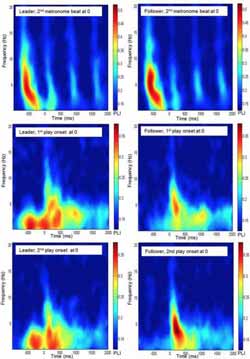Musical duets lock brains as well as rhythms

Time-frequency diagrams of the grand average of the phase locking index, averaged across frontal electrodes for leaders and followers during preparatory tempo setting and around coordinated play onsets.<br><br>Credit: Max Plank Institute, Sänger et al.<br>
Researchers from the Max Planck Institute for Human Development in Berlin have shown that synchronization emerges between brains when making music together, and even when musicians play different voices. In a study published November 29th in Frontiers in Neuroscience, Johanna Sänger and her team used electrodes to record the brain waves of guitarists while they played different voices of the same duet. The results point to brain synchronicity that cannot be explained away by similitudes in external stimulation but can be attributed to a more profound interpersonal coordination.
Scientists working with Ulman Lindenberger at the Max Planck Institute in Berlin already discovered synchronous brain activity between musicians playing the same piece in 2009. The current study goes one step further by examining the brain activity of guitar players performing a piece of music with two different parts. Their aim was to find out whether musicians' brains would synchronize if the two guitarists were not playing exactly the same notes, but instead played different voices of the same song.
To test their hypothesis, the psychologists arranged 32 experienced guitarists in duet pairs, and recorded electrical activity in different brain regions of each musician. They were then asked to play a sequence from the “Sonata in G Major” by Christian Gottlieb Scheidler a total of 60 times, and the duet partners were given slightly different tasks: each musician had to play a different voice, and one of the two was responsible for ensuring that they started at the same time and held the same tempo. Thus, one person took the lead and the other followed.
The duet's brain activities showed coordinated brain oscillations, even when playing different voices of the same duet. Called phase coherence, this synchronous activity suggests a direct neural basis for interpersonal coordination.
“When people coordinate their own actions, small networks between brain regions are formed. But we also observed similar network properties between the brains of the individual players, especially when mutual coordination is very important; for example at the joint onset of a piece of music,” says Johanna Sänger. The difference between leader and follower was also reflected in the results of the measurement of electrical activity captured by electrodes: “In the player taking the lead, the internal synchronization of an individual's brain waves was stronger and, importantly, was present already before the duet started to play,” says Johanna Sänger. “This could be a reflection of the leading player's decision to begin playing at a certain moment in time,” she added.
The current data indicate that synchronization between individuals occurs in brain regions associated with social cognition and music production. And such interbrain networks are expected to occur not only while performing music. “We think that different people's brain waves also synchronise when people mutually coordinate their actions in other ways, such as during sport, or when they communicate with one another,” Sänger says.
Original study:
Johanna Sänger, Viktor Müller and Ulman Lindenberger:
Intra- and interbrain synchronization and network properties when playing guitar in duets. Frontiers in Human Neuroscience, 2012, doi: 10.3389/fnhum.2012.00312
http://www.frontiersin.org/Human_Neuroscience/10.3389/fnhum.2012.00312/abstract
Related article (previous study):
Gehirne im Gleichtakt [Brains in Sync] http://www.mpg.de/577608/pressemitteilung20090317?filter_order=L
Media Contact
More Information:
http://www.mpib-berlin.mpg.deAll latest news from the category: Science Education
Newest articles

“Nanostitches” enable lighter and tougher composite materials
In research that may lead to next-generation airplanes and spacecraft, MIT engineers used carbon nanotubes to prevent cracking in multilayered composites. To save on fuel and reduce aircraft emissions, engineers…

Trash to treasure
Researchers turn metal waste into catalyst for hydrogen. Scientists have found a way to transform metal waste into a highly efficient catalyst to make hydrogen from water, a discovery that…

Real-time detection of infectious disease viruses
… by searching for molecular fingerprinting. A research team consisting of Professor Kyoung-Duck Park and Taeyoung Moon and Huitae Joo, PhD candidates, from the Department of Physics at Pohang University…





















